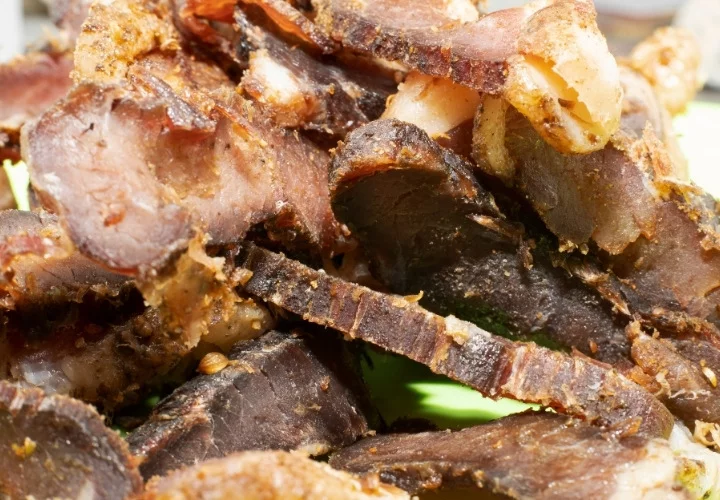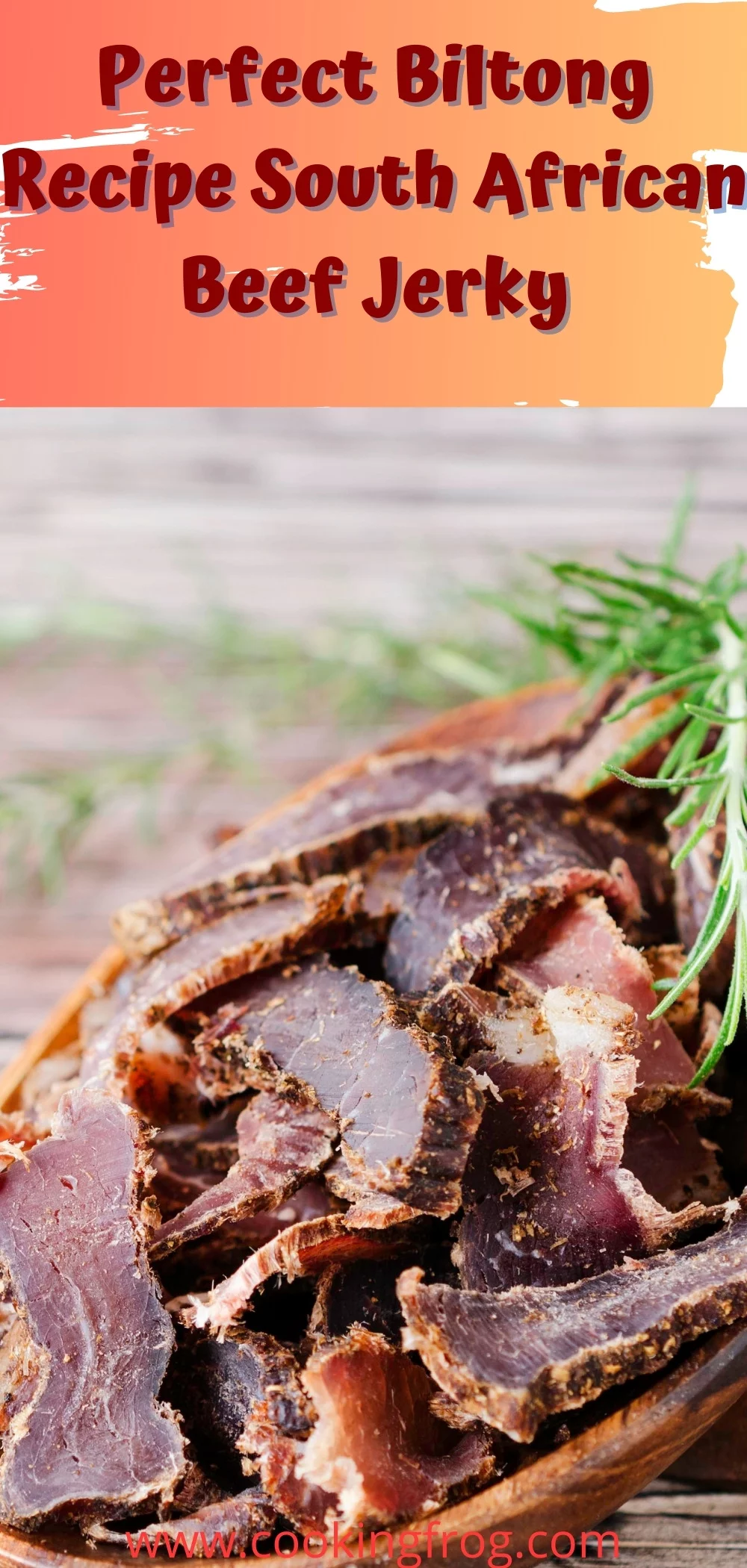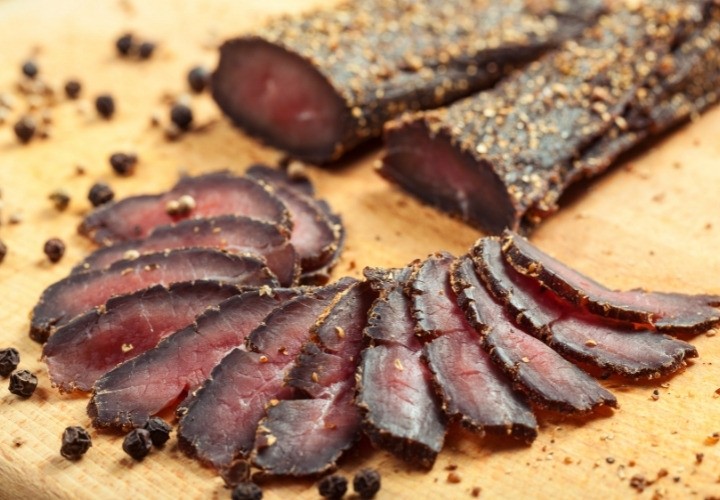Today we’re going to make a perfect biltong recipe! South African Biltong is a Beef Jerky, a cured meat, and is a National snack. Canned beef jerky is not only delicious but is quite expensive as well.
Tender, flavorful, and deeply spiced—homemade biltong is a rewarding project and a true South African classic. Here’s how to make it the traditional way!
Ingredients
-
8 lbs beef hump (or another fatty cut like top round or sirloin tip)
-
⅓ cup whole coriander seeds
-
2 Tbsp mixed peppercorns
-
½ Tbsp finely ground coriander
-
½ Tbsp allspice
-
½ Tbsp powdered cloves
For the Marinade:
-
1 cup Worcestershire sauce
-
½ cup brown vinegar (or malt vinegar)
-
2.5 oz sea salt (about 5 Tbsp)
-
½ cup sugar
Instructions
-
Prepare the Beef:
-
Slice the beef with the grain into strips about 1½ to 2 inches (4–5cm) thick.
-
-
Mix the Marinade:
-
In a bowl, combine Worcestershire sauce, brown vinegar, sea salt, and sugar. Stir until salt and sugar are dissolved.
-
-
Marinate:
-
Place beef strips in a large zip-top bag or shallow dish.
-
Pour the marinade over the beef, turning to coat all sides.
-
Seal and refrigerate for 24 hours, turning occasionally to marinate evenly.
-
-
Toast and Prepare the Spices:
-
In a dry pan over medium heat, toast the whole coriander seeds and peppercorns until fragrant and lightly smoking, about 2–3 minutes.
-
Let cool, then coarsely grind them using a spice grinder or mortar and pestle.
-
In a bowl, combine ground coriander/peppercorns with ground coriander, allspice, and cloves.
-
-
Season the Beef:
-
Remove the beef from the marinade and pat dry with paper towels.
-
Generously sprinkle the spice mix over all sides of the beef, pressing gently so the spices stick.
-
-
Hang and Dry:
-
Attach a labeled paper clip or hook to the end of each strip (note the weight of each strip for accurate drying).
-
Hang the beef strips in a cool, well-ventilated area (below 68°F/20°C is best), away from direct sunlight.
-
Let dry for 4–5 days, or until the strips have lost 40–45% of their weight. (For chewier biltong, dry less; for drier, dry more.)
-
-
Slice & Enjoy:
-
Slice the finished biltong thinly against the grain for best texture.
-
Enjoy as a snack, in breakfast, or as a protein-packed lunch addition.
-
Tips
-
Thicker strips need more drying time.
-
Use a biltong box, dehydrator, or a fan for consistent airflow if your environment is humid.
-
Adjust spice amounts to your taste—some like extra pepper or coriander!
Tips & Tricks
- Selection of the cut of meat is very important. My favorite cut is a top rump with a thick layer of fat. Other popular cuts include silverside and topside. If you are feeling fancy, make it with rump or striploin. Whatever you choose, pick a piece of meat with a nice fat layer to make perfect Biltong’s.
- Don’t forget to cut the strips of meat along the grains. When you cut Biltong’s, that too will be done along the grains.
- Make sure not to grind the spices too fine; you should be able to identify spices even after grinding them.
- Coat the meat with your spice mix, making sure it’s fully covered.
- Don’t skip the paper clipping and weight measuring step, as it is important to track the water loss during the curing process.
- A lot of the spices might fall off during the handling and curing process so place a tray below to prevent wastage of the spices.
- Hang the meat in a place with good airflow. Maintaining good hanging conditions will prevent the spoilage of meat.
- Cut the Biltong’s as fine as you can but along the grains.
Nutrition Facts
Here is the nutrition profile of a 1 ounce of beef biltong serving.
- Calories: 80
- Carbohydrates: 1g
- Proteins: 16g
- Fats: 2g
FAQs
How to store beef jerky?
You can store beef jerky in any sealed airtight bag and enjoy it for one week without refrigerating it. If you want to keep it fresh for longer, then freezing it will keep your homemade beef jerky fresh for up to one or two months. A vacuum-sealed bag is the best option for storing jerky, but a zip lock bag also goes well.
How to check the freshness of beef jerky?
If you notice any change in the color or odor of the beef jerky, it strongly indicates that beef jerky is spoiled and, you need to throw it away.
How much time does it take to dry the beef jerky?
The drying time of beef jerky actually depends on the size of meat as well as the drying method you opted for. I suggest you focus on the moisture content of the meat. Once the meat has lost 45 to 50% moisture, you are done with the dehydrating process. Medium wet beef jerky having lots of fat is the best texture one can achieve through following a perfect biltong recipe.
How to protect the beef jerking from molds?
Beef jerky is susceptible to molds, so its protection requires taking the following precautions.
- Molds can grow if the airflow is not good enough or humidity is high. Rectify these drying conditions to prevent mold from growing on the meat strips.
- Properly dry the meat to enhance the storage life of the beef jerky.
- Prevent the supply of oxygen by storing jerky in an airtight bag as oxygen is the biggest culprit behind the fungus growth.
- Prefer freezing the Biltong over refrigeration.
Why is my jerky too hard?
The perfect texture of jerky depends on the drying time. You might have dried your jerky more than required. Moisture loss of more than 70% makes jerky hard and tough, so always prefer medium wet jerky with 45 to 50% moisture content.
Conclusion
I hope you’ll find this recipe super easy to make. Although making a perfect beef jerky does require time and energy, but making a nutrient-rich snack at home is far way better than buying expensive canned beef jerky.
If you liked my recipe, give it a try, share it with friends, and do let us know about your experience.
Thanks!




